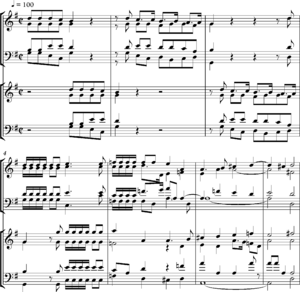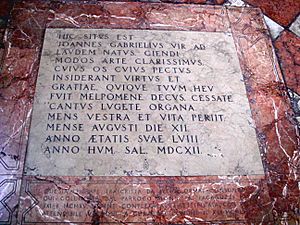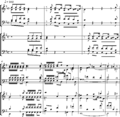Giovanni Gabrieli facts for kids
Giovanni Gabrieli (born around 1554 or 1557 – died August 12, 1612) was an Italian composer and organist. He was one of the most important musicians of his time. His music shows the best of the "Venetian School" style. He also helped music change from the Renaissance period to the Baroque period.
Contents
About Giovanni Gabrieli
Giovanni Gabrieli was born in Venice, Italy. He was one of five children. His father moved to Venice from another region just before Giovanni was born. We don't know much about Giovanni's early life. However, he likely learned music from his uncle, Andrea Gabrieli. His uncle was also a composer and worked at St Mark's Basilica in Venice. Giovanni may have even been raised by his uncle. He once wrote that he was "little less than a son" to him.
Giovanni also traveled to Munich to study with the famous composer Orlande de Lassus. He probably stayed there until about 1579. Lassus had a big impact on Giovanni's musical style.
By 1584, Giovanni was back in Venice. In 1585, he became the main organist at St Mark's Basilica. This happened after another musician, Claudio Merulo, left the job. When his uncle died the next year, Giovanni also became the main composer there. He spent a lot of his time editing and publishing his uncle's music. This saved many pieces that might have been lost forever.
Gabrieli's career grew even more when he also became an organist at the Scuola Grande di San Rocco. This was a very important and rich group in Venice. It was almost as grand as St Mark's Basilica for music. Some of Italy's best singers and musicians performed there. Giovanni wrote much of his music for this place, and even more for St Mark's.
St Mark's Basilica was known for its excellent music for a long time. Gabrieli's work there made him one of the most famous composers in Europe. His important book, Sacrae symphoniae (published in 1597), became very popular. Composers from all over Europe, especially Germany, came to Venice to learn from him. He taught them the grand Venetian polychoral style. This style uses multiple groups of singers and instruments. He also taught them about madrigals, which are smaller vocal pieces. Musicians like Heinrich Schütz took these new ideas back to Germany. This greatly influenced German music, leading to famous composers like J.S. Bach.
Giovanni Gabrieli became more and more ill after 1606. Church leaders had to appoint others to help with his duties. He passed away in Venice in 1612. He died from problems caused by a kidney stone.
Gabrieli's Music Style

Gabrieli wrote many types of music. But he mostly focused on sacred (religious) vocal and instrumental music. His early works included some secular (non-religious) vocal music. However, he never wrote lighter music like dances. Later, he focused on religious music that used sound in powerful ways.
He introduced many new ideas in music. While he wasn't always the very first to use them, he was the most famous composer of his time to do so. These ideas included:
- Dynamics: This means writing down how loud or soft the music should be played. A famous example is his piece Sonata pian' e forte, which means "sonata soft and loud."
- Specific Instruments: He wrote down exactly which instruments should play which parts. Before him, composers often let musicians choose.
- Multiple Groups: He used large groups of musicians placed in different spots. This created a "stereo" effect. This idea led to the Baroque concertato style. In this style, different groups of instruments or voices play together or in turns. This style quickly spread across Europe.
Gabrieli used the special design of St Mark's Church. It had two choir lofts facing each other. This allowed him to create amazing sound effects. Most of his pieces are written so that one group of musicians plays, and then another group on the other side answers. Sometimes, a third group played near the main altar in the middle. This "polychoral" style had been around for decades. But Gabrieli was the first to use specific groups of instruments and singers. He gave clear instructions for how they should play. The church's acoustics (how sound travels) were perfect for this. Even a single string player could sound balanced against a large group of brass instruments. A great example of this is his piece In Ecclesiis.
Gabrieli's first motets (religious vocal pieces) were published in 1587. They showed his uncle's influence, using dialogue and echo effects. His 1597 Sacrae Symphoniae motets moved beyond simple echoes. They developed musical ideas through different groups of singers. In these motets, instruments were a key part of the performance.
After 1605, Gabrieli's style changed. His music became more homophonic. This means that all parts move together, like a hymn, instead of each part having its own melody. He started including sections just for instruments, called "Sinfonia." He also wrote small sections for solo singers with simple accompaniment. "Alleluia" refrains often created a repeating pattern in his motets.
One of his most famous pieces, In Ecclesiis, shows off these techniques. It uses four separate groups of instruments and singers. An organ and continuo (a continuous bass line) support the whole piece.
Important Works
Giovanni Gabrieli's music was published in several important collections.
Concerti (1587)
This collection was called Concerti di Andrea, et di Giovanni Gabrieli, organisti della Serenissima Signori di Venetia. It had 77 pieces. Most were by his uncle, Andrea Gabrieli. But it also included some of Giovanni's own polychoral motets.
Sacrae Symphoniae (1597)
This was a very important collection. It included:
- 45 motets (religious vocal pieces) for 6, 7, 8, 10, 12, 14, 15, or 16 voices.
- 14 canzonas (instrumental pieces) for 8, 10, 12, or 15 musical lines.
- Two sonatas (instrumental pieces), one for 8 lines and one for 12.
A famous piece from this collection is the Sonata pian e forte.
Canzoni per sonare (1608)
This collection had 36 short pieces by Gabrieli and other composers like Girolamo Frescobaldi. Gabrieli wrote the first four pieces, and two others in the collection.
Canzoni e Sonate (published 1615)
This collection was published after Gabrieli's death in 1615. It included 16 canzoni and 5 sonatas. These pieces were for many different numbers of "voices" (musical parts). They were meant to be played with "all sorts of instruments, with bass by means of the organ."
Sacrae Symphoniae II (published 1615)
This was a second book of Sacrae symphoniae, also published after his death in 1615. It included many more motets and other religious pieces. One of the most well-known pieces from this collection is Motet "In ecclesiis" a 14.
Images for kids
See also
 In Spanish: Giovanni Gabrieli para niños
In Spanish: Giovanni Gabrieli para niños



